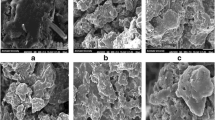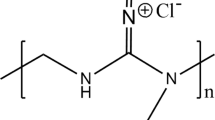Abstract
This paper addressed construction and biodegradability assessment of chiral synthetic poly(amide-imide)s (PAI)s. These polymers were prepared by polycondensation reaction of chiral diacids; N-trimellitylimido-S-valine (7a), and N-trimellitylimido-l-leucine (7b) with 5-(2-benzimidazole)-1,3-phenylenediamine (4) in the presence of tetrabutylammonium bromide as a green media under microwave irradiation. The morphology observations of the aforementioned polymers exhibit that these macromolecules are nanostructured particle and so, good candidate as carrier for biomedical application. Furthermore, in vitro toxicity and soil biodegradability test of the different synthetic diacids (7a, 7b) and the obtained PAIs were employed to evaluate the biological activity of these materials. In Petri plate technique, the monomers and obtained polymers exposed on glass lamels were all colonized by fungal saprophytes and due to this invasion, a weight loss up to 35 % was observed in the material. The soil burial test and measuring dehydrogenase activity revealed that the aforementioned monomers and polymers are biologically active and probably biodegradable under the soil. Normal wheat seedling growth took place in the vials containing the aforesaid monomers and polymers. It could be concluded that the synthesized monomers and their polymers are biologically active, and they are nontoxic to ecosystems and natural environments.







Similar content being viewed by others
References
Stenzenberger HD, Hergenrother PM (1990) Polyimides–chemistry and applications. Blackie, Glasgow
Ghosh MK, Mittal KL (1996) Polyimides: fundamentals and applicators. Marcel Dekker, New York
Kolahdoozan M, Mirsafaei R, Mallakpour S (2012) Synthesis and properties of new highly soluble poly(amide-ester-imide)s containing poly(ethylene glycol) as a soft segment. Polym Bull 68:1239–1254
Mallakpour S, Madani M (2012) A facile route for the preparation of novel optically active poly(amide–imide)/functionalized zinc oxide nanocomposites containing pyromellitoyl-bis-l-phenylalanine moieties. Polym Bull 68:1201–1214
Mallakpour S, Dinari M (2013) Straightforward and green method for the synthesis of nanostructure poly(amide-imide)s-containing benzimidazole and amino acid moieties by microwave irradiation. Polym Bull 70:1049–1064
Shockravi A, Abouzari-Lotf E, Javadi A, Atabaki F (2009) Preparation and properties of new ortho-linked polyamide-imides bearing ether, sulfur, and trifluoromethyl linkages. Eur Polym J 45:1599–1606
Liaw DJ, Chen WH (2006) High glass transitions of novel organosoluble polyamide-imides based on noncoplanar and rigid diimide-dicarboxylic acid. Polym Degrad Stab 91:1731–1739
Mallakpour S, Zeraatpisheh F (2011) Construction and characterization of bionanocomposites based on optically active poly(ester-imide) containing l-amino acids using nano-ZnO surface-coupled by γ-methacryloxypropyl-trimethoxysilane. Des Monomers Polym 14:487–498
Robertson GP, Guiver MD, Yoshikawa M, Brownstein S (2004) Structural determination of Torlonw 4000T polyamide–imide by NMR spectroscopy. Polymer 45:1111–1117
Hong CY, Gwak KS, Lee SY, Kim SH, Lee SM, Kwon M, Choi IG (2012) Biodegradation of PCB congeners by white rot fungus, Ceriporia sp. ZLY-2010, and analysis of metabolites. J Environ Sci Health Part A 47:1878–1888
Mallakpour S, Rafiee Z (2011) Ionic liquids as environmentally friendly solvents in macromolecules chemistry and technology, part I. J Polym Environ 19:447–484
Vygodskii YS, Lozinskaya EI, Shaplov AS, Lyssenko KA, Antipin MY, Urman YG (2004) Implementation of ionic liquids as activating media for polycondensation processes. Polymer 45:5031–5045
Ranu BC, Dey SS, Hajra A (2003) Catalysis by an ionic liquid: efficient conjugate addition of thiols to electron deficient alkenes catalyzed by molten tetrabutylammonium bromide under solvent-free conditions. Tetrahedron 59:2417–2421
Kantevari S, Chary MV, Das APR, Vuppalapati SVN, Lingaiah N (2008) Catalysis by an ionic liquid: highly efficient solvent-free synthesis of aryl-14H-dibenzo[a.j]xanthenes by molten tetrabutylammonium bromide under conventional and microwave heating. Catal Commun 9:1575–1578
Kurumurthy C, Kumar GS, Reddy GM, Nagender P, Rao PS, Narsaiah B (2012) A facile strategy for the synthesis of highly substituted imidazole using tetrabutyl ammoniumbromide as catalyst. Res Chem Intermed 38:359–365
Chen GQ, Patel MK (2012) Plastics derived from biological sources: present and future—a technical and an environmental review. Chem Rev 112:2082–2099
Lithner D (2011) Environmental and health hazards of chemicals in plastic polymers and products. A PhD Thesis, University of Gothenburg, Sweden
Guo K, Chu CC (2007) Synthesis, characterization, and biodegradation of novel poly(ether ester amide)s based on l-phenylalanine and oligoethylene glycol. Biomacromolecules 8:2851–2861
Edlund U, Albertsson AC (2003) Polyesters based on diacid monomers. Adv Drug Deliv Rev 55:585–609
Wang B, Zhang Y, Guo Z, Cheng J, Fang Z (2011) Biodegradable aliphatic/aromatic copoly(ester-ether)s: the effect of poly(ethylene glycol) on physical properties and degradation behavior. J Polym Res 18:187–196
Abadie MJM, Sillion B (1991) Polyimides and other high-temperature polymers. Elsevier, Amsterdam
Volksen W (1994) Advances in polymer science. In: Hergenrother PM (ed), vol. 117, Springer, Berlin
De Abajo J, De la Campa JG (1999) Advances in polymer science, vol 140. Springer, Berlin
Gnanou Y, Fontanille M (2008) Organic and physical chemistry of polymers. Wiley, NJ
Hsiao SH, Yang CP, Chen YC, Wang HM, Guo W (2009) Synthesis and properties of poly(ether-imide)s derived from 2,5-bis(3,4-dicarboxyphenoxy)biphenyl dianhydride and aromatic ether-diamines. J Appl Polym Sci 113:3993–4002
Yeganeh H, Tamami B, Ghazi I (2005) Synthesis and properties of novel optically active and soluble aromatic/aliphatic polyimides via reaction of dianhydrides and diisocyanates. Iran Polym J 14:277–285
Katsarava R, Beridze V, Arabuli N, Kharadze D, Chu CC, Won CY (1999) Amino acid-based bioanalogous polymers. synthesis, and study of regular poly(ester amide)s based on bis(α-amino acid) α, ω-alkylene diesters, and aliphatic dicarboxylic acids. J Polym Sci A Polym Chem 37:391–407
Nagai A, Ishikawa J, Kudo H, Endo T (2004) Synthesis of optically active polyurethanes by self-polyaddition of tyrosine-based monomers. J Polym Sci A Polym Chem 42:1143–1153
Fan Y, Kobayashi M, Kise H (2001) Synthesis and specific biodegradation of novel polyesteramides containing amino acid residues. J Polym Sci A Polym Chem 39:1318–1328
Feng L, Hu J, Liu Z, Zhao F, Liu G (2007) Preparation and properties of optically active poly(N-methacryloyl l-leucine methyl ester). Polymer 48:3616–3623
Lease CWM (2006) Biodegradation of high molecular weight polycyclic aromatic hydrocarbons in soils by defined bacterial and fungal cocultures. A PhD Thesis, Flinders University of South Australia
Reddy CA, Mathew Z (2001) Bioremediation potential of white rot fungi Fungi in bioremediation. In: Gadd GM (ed) Fungi in bioremediation. Cambridge University Press, Cambridge
Sukor MZ, Yin CY, Savory RM, Abdul-Talib S (2012) Biodegradation kinetics of naphthalene in soil medium using pleurotus ostreatus in batch mode with addition of fibrous biomass as a nutrient. Bioremediation J 16(3):177–184
Russell JR, Huang J, Anand P, Kucera K, Sandoval AG, Dantzler KW, Hickman D, Jee J, Kimovec FM, Koppstein D, Marks DH, Mittermiller PA, Núñez SJ, Santiago M, Townes MA, Vishnevetsky M, Williams NE, Vargas MPN, Boulanger L-A, Bascom-Slack C, Strobel SA (2011) Biodegradation of polyester polyurethane by endophytic fungi. Appl Environ Microbiol 77(17):6076–6084
Ryu WR, Shim SH, Jang MY, Jeon YJ, Oh KK, Cho MH (2000) Biodegradation of pentachlorophenol by white rot fungi under ligninolytic and nonligninolytic conditions. Biotechnol Bioprocess Eng 5:211–214
Dashtban M, Schraft H, Syed TA, Qin W (2010) Fungal biodegradation and enzymatic modification of lignin. Int J Biochem Mol Biol 1(1):36–50
Ali Shah A, Hasan F, Hameed A (2010) Degradation of poly(3-hydroxybutyrate-co-3-hydroxyvalerate) by a newly isolated Actinomadura sp. AF-555, from soil. Int Biodeter Biodegr 64(4):281–285
Vidali M (2001) Bioremediation. An overview. Pure Appl Chem 73(7):1163–1172
Ogilvie LA, Hirsch PR (2013) Microbial ecological theory: current perspectives. Caister Academic Press, Norfolk
Mallakpour S, Banihassan K, Sabzalian MR (2013) Novel bioactive chiral poly(amide–imide)s containing different amino acids linkages: studies on synthesis, characterization and biodegradability. J Polym Environ 21:568–574
Mallakpour S, Zeraatpisheh F, Sabzalian MR (2012) Construction, characterization and biological activity of chiral and thermally stable nanostructured poly(ester-imide)s as tyrosine-containing pseudo-poly(amino acid)s. J Polym Environ 20:117–123
Mallakpour SE, Hajipour AR, Shahmohammadi MH (2002) Novel optically active poly(amide-imide)s from N-trimellitylimido-S-valine and aromatic diamines by direct polycondensation reaction. Iran Polym J 11(6):425–431
Staubli A, Ron E, Langer R (1990) Hydrolytically degradable amino acid containing polymers. J Am Chem Soc 112:4419–4424
Mallakpour S, Khani M (2014) Microwave-Assisted Construction of nanostructured poly(amide-imide)s containing environmental friendly natural amino acids via implementation of molten salt ionic liquid as an activating media. Polym Plast Technol Eng 53(1):38–45
Muhammad A, Wang HZ, Wu JJ, Xu JM, Xu DF (2005) Change in enzyme activity, substrate utilization pattern and diversity of soil microbial communities under cadmium pollution. J Environ Sci 17:802–807
Ayala V, Maya EM, Garcia JM, De La Campa JG, Lozano AE, De Abajo J (2005) Synthesis, characterization, and water sorption properties of new aromatic polyamides containing benzimidazole and ethylene oxide moieties. J Polym Sci Part A Polym Chem 43:112–121
Eaton PE, Carlson GR, Lee JT (1973) Phosphorus pentoxide-methanesulfonic acid. A convenient alternative to polyphosphoric acid. J Org Chem 38:4071–4073
Frost LW, Bower GM, Freeman JH, Burgman HA, Traynor EJ, Ruffing CR (1968) Benzimidazole- and oxadiazole-modified aromatic polyimides. J Polym Sci Part A Polym Chem 6:215–233
Acknowledgments
We wish to express our gratitude to the Research Affairs Division of Isfahan University of Technology (IUT), for financial support. Further financial support from National Elite Foundation (NEF) and Center of Excellency in Sensors and Green Chemistry Research (IUT) is gratefully acknowledged.
Author information
Authors and Affiliations
Corresponding author
Rights and permissions
About this article
Cite this article
Mallakpour, S., Khani, M. & Sabzalian, M.R. Synthesis and biodegradability assessment of poly(amide-imide)s containing N-trimellitylimido-l-amino acid and 5-(2-benzimidazole)-1,3-phenylenediamine. Polym. Bull. 71, 2159–2172 (2014). https://doi.org/10.1007/s00289-014-1179-1
Received:
Revised:
Accepted:
Published:
Issue Date:
DOI: https://doi.org/10.1007/s00289-014-1179-1




